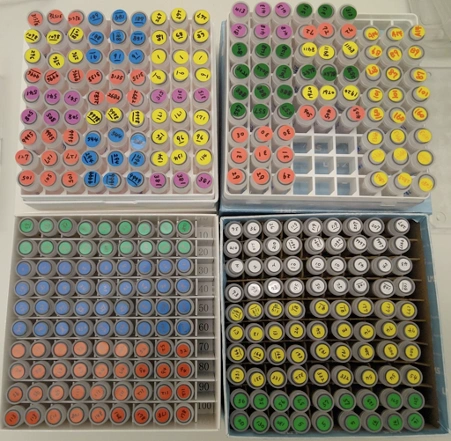Introduction
This is Imura, COGNANO representative. First of all, let me introduce Director Maeda, who wrote the main part of this blog.
When we learned of the Diamond Princess incident, COGNANO took the helm in new-type corona drug discovery. Since then, we have already been working for more than two years on a project to develop not only drugs but also a tracking drug discovery principle to track "viral mutations" and to build a huge library of antibody information. The person who continued to fight, forgetting to eat and sleep, was Mr. Maeda, the head of the Research and Development Department. He is a bio innovator who uses genetic engineering, protein and antibody engineering, and structural science as weapons to cut through with new methods.
In September 2020, we had already discovered "an antibody that is effective against omicrons, which will emerge in a year's time," but we had to spend a lot of time in the bio journal's peer review process took time and the paper was not accepted until a year and a half later. This blog will not go into the pros and cons of the journal's peer review system. Nevertheless, the publication of the "alpaca antibody" paper is a good opportunity for me to describe a review of the past two years in this blog. Dr. Maeda is the first author of the paper.

Good work! I would like to say that we are not done with Corona at all. Of course, bioscience and social operation are not the same, and we cannot hope for a unified solution. I have the impression that the public is feeling "fed up" and anxious about the uncertain future, and is unable to make up its mind how to face the situation.
In this sense, what COGNANO as a bio & IT tech should do is clear from the start. Viral mutations are beyond human expectations, so we need to find out how far we can go with our data and computational power, and whether we can take countermeasures even if viruses should become more virulent. At COGNANO, we are now at the stage where the vast amount of antibody data and computational power that we have been accumulating for more than two years are mutually reinforcing each other, and we believe that tracking viral genome mutations has mathematical value in and of itself. This is the only project COGNANO is pursuing in the world.
This is because the diverse antibody data corresponding to mutations can only be obtained from individuals (whether human or animal) that recognize the mutation type, but since next-generation sequencers (NGS) cannot be used to decipher human antibody genes, a large amount of antibody information can only be tracked via camelids. The competition for survival (cooperation for survival?) between humans and viruses The mutual changes (data pairs of viral mutation and antibody diversity) that are realistically selected in the competition for survival between humans and viruses (cooperation for survival?) are "a rare chance given by nature" that can be obtained only once every 100 years. Is it possible for a space researcher to make a decision not to take data from a supernova explosion, which can only be observed rarely?
As Maeda describes, the fact that the U.S. team that took advantage (even partially) of the SARS-CoV1 data 20 years ago was the winner in antibody drug discovery is proof of the strict rules. Those who turn a blind eye will not stand a chance, says this blog. Currently, mutations such as omicron BA.5, BA.2.75 (centaurs), etc. are in progress, all of which we are tracking as we continue our search for a workable antibody. I believe that this Maeda blog will be a valuable record for bio-developers to look back on.
Now, please go to the main part of Director Maeda's blog.

What the Right Researchers Have in Common
The "right" bioman, especially a biochemist, has some common characteristics. First, the protein of interest can be purified. The purified protein has the expected bioactivity. Sometimes, even protein crystals can be produced. Unfortunately, this type of "down-to-earth" biochemist may now be endangered. Legitimate professionals do not use proteins made by others. They do not believe in commercially available proteins. Biochemistry experts consider proteins purified from living organisms to be the best, and those purified from cultured cells to be the next best. Proteins derived from other species have increased risks and errors that are not appropriate for human drug discovery. Even today, this is a nerve-wracking area that requires craftsmanship.
If you are a professional, it is the unknown proteins - the new corona spikes - that challenge you in the best way. At the beginning of the pandemic, biochemists around the world took on the challenge of purifying the spike protein. This is the "right" approach to biochemistry. The goal was to understand the spike protein and neutralize the virus.
When the lid was lifted, it was the experts who had been working on SARS since 2002 who led the research on the new coronavirus. They had over a decade of experience with the "old" spike protein. They were the first to purify and determine the structure of the new corona spike protein.
Even though there were no cases of infection in the U.S. at the time, the quarantine department described it as a "War. In fact, the Japanese infection prevention division also paid attention to it, and the description from that time remains. There may be a latent difference in the sense of bio-threats.
Patients who are infected with and recover from novel coronas have antibodies that neutralize the virus through an immune response. Purified novel corona spike proteins can be used to collect those antibodies. By decoding the genes of the cells (lymphocytes) that produce those antibodies, we were able to list the antibodies that neutralize the new-type coronaspike protein.
Multiple sites were seamlessly maintained in the U.K. and U.S.
The earliest successes were by research groups in the United States and the United Kingdom. There is a clear reason why they were the only ones who were able to do it. They had developed a method for finding antibodies that neutralized the AIDS virus, Ebola virus, and other viruses before the pandemic. They had a system in place to share patient samples, technology to sort (sort) lymphocytes and decode their genes, a pipeline to purify large quantities of antibodies, and a system that was transparent in its approvals and responsible in its use. These seamless infrastructures were in place.
Hundreds of similar studies were followed by hundreds of academia and ventures around the world. Some research teams in Europe, the U.S., and the U.K. were able to catch up with the top teams, but they were unable to overtake them. And even after the appearance of the new mutant strain (Omicron) on November 26, 2021, " survived" only those groups that had continued their research before the pandemic. As a matter of fact, the antibody (commercially available product) that can also neutralize the omicron mutant virus was unearthed from patient stored samples recovered from infection with SARS-CoV1 (old corona) (Sotrovimab by GSK). After all, it was quite difficult to bridge the 20-year gap in experience. As a result, it became clear that there was virtually no vaccine or drug discovery capability outside of Europe, the US, and the UK.

What experiences promise success?
What exactly is the "difference in experience" here? It can be captured by dividing it into several factors.
- the quality of the new coronaspike protein (biochemistry)
- the genetic assets of antibody immunity (antibody gene libraries)
- the amount of antibody amino acid sequence data to analyze (programming)
- how to organize demonstration experiments (handling of wet bioviruses)
The new coronaspike protein must be at least a special grade expressed in mammalian cells The research groups that did not do well mainly used the following Receptor binding domains (RBDs), which are only part of the new corona spike protein. Spike proteins expressed in insect cells. Commercial products. These can reduce the success rate of drug discovery.
The best organism to produce antibodies is a recovered infected patient (human). The next best are vaccinated humans and infected or immunized animals. Unsuccessful research groups have used animals that were not fully immunized or even tried to find antibodies in the lymphocyte genes (naïve libraries) of animals that were not even immunized.
The excellence of the antibodies correlates with how much effort was put into discovery (mining from gene libraries). The maximum number of antibody genes that could be found from patients was a few dozen, even for the best research teams in the world. From research mice, the upper limit is on the order of a hundred. COGNANO is using a next-generation sequencer to search for antibodies that recognize spike proteins in 30 million varieties. COGNANO has accumulated 30 million types of antibodies that recognize spike proteins by analyzing them with a next-generation sequencer. However, this type of research is just beginning and only a few teams in the world are aware of it. We are the first generation to be able to take enormous amounts of antibody data, but next to the data, IT technology is required to "compute and process" the data. COGNANO is at the forefront of this.
Finally, we must experimentally verify whether the unearthed antibodies neutralize the virus. The supreme method is to administer the drug to patients and see its effects. However, it is not possible to experiment on the human body, so the next best method is to administer the virus to infected animals. As a mimicry method, the use of cultured cells infected with the virus is a reproducible and quantitative method. However, it should be noted that this is only an in vitro phenomenon. More importantly, it is also very important to know what part of the spike protein the antibody binds to (the epitope). This is because it logically tells us which mutants the antibody will be effective against and which newer mutants it will not. The technique of photographing the binding of antibodies to spike proteins (cryo-electron microscopy) has just started operating in Japan, this time at Osaka University, but it has been standard practice in the US and Europe for several years now, with cooperation between academia and pharmaceutical companies. All of the successful groups were conducting viral infection experiments as a matter of course, and also conducted epitope determination at the global standard level. The ability to seamlessly fulfill these items ...... The common capability of the winners was the facility provided in the developed countries.
Only those research groups that met these four elements were able to proceed to the summit. And with the advent of the Omicron strain, the research groups that were defeated had their own reasons. If you look at the papers published by each group, you will find reasons between the lines as to why they did not do their best. More than 80% of the research groups lost because they did not do their best to produce viral proteins. In addition, none of the groups that started with non-immunizing methods (in humans or animals) were successful.
Those who can go to heaven are those who know the way to hell
All "successful teams" are alike, not just in their research on new coronaviruses. As the ancients said.
He who can go to heaven is he who knows the way to hell.
The winners were limited to teams that had experienced firsthand how to fail, paid the cost, and did not give up a decade earlier. As a result, the winners were almost exclusively Anglo-American (companies and academia). These are the facts that became clear in the war in the name of pandemics. I believe that the time has come for us to seriously consider how we will accept this challenge. (Ryota Maeda, COGNANO Development Director)